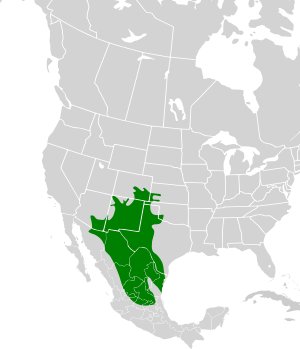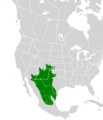Scaled quail facts for kids
Quick facts for kids Scaled quail |
|
|---|---|
 |
|
| Scaled quail in Arizona | |
| Conservation status | |
| Scientific classification | |
| Genus: |
Callipepla
|
| Species: |
squamata
|
| Subspecies | |
|
See text |
|
 |
|
| Synonyms | |
|
Ortyx squamatus Vigors, 1830 |
|
The scaled quail (Callipepla squamata) is also known as the blue quail or cottontop. It is a type of New World quail, a bird family found in the Americas. This bird is bluish-gray and lives in dry areas from the Southwestern United States down to Central Mexico.
The scaled quail gets its name from the feathers on its chest and back. These feathers look like small scales. Another easy way to spot this bird is its white crest on its head. It looks like a fluffy tuft of cotton!
Scaled quail usually build their nests in a hollow in the ground. They line the nest with grass. A female quail lays about 9 to 16 speckled eggs. If something scares a scaled quail, it usually prefers to run away rather than fly.
These birds are common in their natural homes. Because of this, the IUCN Red List of Threatened Species says the scaled quail is a species of "Least Concern." This means it is not currently in danger of disappearing.
Contents
Where Scaled Quail Live and Their Types
Scaled quail live in many places. You can find them from Arizona, New Mexico, Colorado, and Kansas in the US. Their range goes south through Oklahoma and Texas into Mexico. In Mexico, they live in areas like Jalisco, Guanajuato, and Tamaulipas.
People have also brought scaled quail to other places. These include Cuba, Jamaica, Haiti, the Dominican Republic, and Puerto Rico. In the United States, they were introduced to Hawaii, Washington, Nevada, and Nebraska. However, they have only really settled and grown in central Washington and eastern Nevada.
There are different types, or subspecies, of scaled quail. Three of these subspecies live in the USA:
- Callipepla squamata squamata (Altiplano scaled quail). This is the original type. It lives only on the Central Plateau (altiplano) of Mexico.
- Callipepla squamata pallida (northern scaled quail). This is the most common type. It lives from Arizona and New Mexico to Colorado. You can also find it in Oklahoma, western Texas, and parts of northern Chihuahua and Sonora in Mexico. This type is lighter in color than the original type.
- Callipepla squamata hargravei (Upper Sonoran scaled quail). This type lives in dry areas. You can find it where Colorado, Kansas, and Oklahoma meet. It also lives in northwestern New Mexico. This is the palest type, which helps it blend into dry, sandy places.
- Callipepla squamata castanogastris (chestnut-bellied scaled quail). This type lives in southern Texas. Its belly is a chestnut brown color, which makes it different from all other types. It is also darker than the other two types found in the USA.
Plants Scaled Quail Like
Scaled quail often live where certain plants grow. These plants include mesquite (Prosopis spp.), condalia (Condalia spp.), and cholla cactus (Cylindropuntia spp.).
In Oklahoma, scaled quail live in areas with sand sagebrush (Artemisia filifolia) and grasslands. They also like areas with pinyon and juniper trees. These areas often have plants like soapweed yucca (Yucca glauca), skunkbush sumac (Rhus trilobata), and sand plum (Prunus watsonii). Scaled quail in Oklahoma prefer hilly land. They especially like places with sagebrush (Artemisia spp.), mesquite, cactus (Opuntia spp.), yucca, juniper, and rocks for cover.
In Colorado, scaled quail live in sand sagebrush or yucca plants on sandy ground. They use sand sagebrush-grasslands and pinyon-juniper areas a lot. They also use dense cholla-grasslands. They don't use areas with sparse cholla, streamsides, or open grasslands very much.
Life Cycle and Reproduction
Scaled quail start pairing up and spreading out by mid-June in Arizona. Nesting usually begins in early July. In Oklahoma, females start laying eggs in late April. In Texas and Mexico, egg laying happens from March to June. In New Mexico, it's from April to September.
A female scaled quail lays between 9 and 16 eggs. Most often, they lay 12 to 14 eggs. The female sits on the eggs for 21 to 23 days until they hatch. Sometimes, a pair of scaled quail will have two sets of babies in one season. In west Texas, it was seen that the male quail would raise the first group of young birds. Meanwhile, the female would start laying a second set of eggs.
The baby quail are called "precocial young." This means they can leave the nest very soon after hatching. They follow their parents, who show them how to find food. The young birds grow quickly. They reach adult size in about 11 to 15 weeks.
Scaled quail don't move around a lot. In winter, a group of scaled quail, called a covey, stays in an area of about 24 to 84 acres (9.7 to 34 hectares). Different coveys usually don't share much of their living space. From September to November, coveys stay in their own areas. In Arizona, many birds move from their breeding areas to nearby mountain foothills by mid-November. They return in March.
A winter covey of scaled quail usually has about 30 birds. However, some coveys have been seen with as many as 150 birds!
Where Scaled Quail Like to Live
Scaled quail live in dry, open valleys, plains, and hills. They also like rocky slopes, gullies, and canyons. These places have a mix of bare ground, low plants, and scattered bushes. Good scaled quail homes have low grasses with other small plants and shrubs. About 10% to 50% of the ground should be covered by plants. Trees and shrubs should be shorter than 6.6 feet (2 meters). Scaled quail avoid thick plants found near streams.
It's not fully clear if scaled quail need open water sources. Some studies say they can live 7 or 8 miles (11 or 13 km) from water in Arizona. In New Mexico, they were found 10 to 15 miles (16 to 24 km) from water. However, in Arizona, scaled quail were seen drinking at water tanks every 2 to 3 days during dry periods. In Oklahoma, they often move closer to farms and ranches in winter, which means they are closer to water.
Places for Safety
Scaled quail use different types of cover for different activities:
Feeding Cover: While eating, scaled quail use clumps of grass and shrubs for safety. They are often seen crossing open ground. If they are scared, they hide in snakeweed (Gutierrezia spp.) or in grass clumps.
Loafing Cover: After eating in the morning, scaled quail coveys rest in "loafing cover." This is a safe place to relax. These spots usually have:
- Overhead woody plants for shade.
- Plants on the sides to hide them.
- A clear area in the middle with bare ground.
- One or more paths to get in and out easily.
Cholla cactus is often used for overhead cover. In areas without cholla, plants like wolfberry (Lycium spp.) and mesquite are important. This overhead cover gives them shade during the middle of the day. It also has an open base, so they can quickly escape from predators.
Night-Roosting Cover: At night, scaled quail sleep in plants like yucca (Yucca angustifolia), tree cholla, and true mountain-mahogany (Cercocarpus montanus). The plants they use for sleeping at night are usually less than 1.6 feet (0.5 meters) tall.
Nesting Cover: In March or April, winter coveys spread out into areas with less cover. This happens when there are fewer birds of prey (like hawks) around. Scaled quail build their nests under clumps of grass. The nests are hidden by plants like sagebrush (Artemisia spp.), creosotebush (Larrea tridentata), mesquite, catclaw acacia (Acacia greggii), cactus, or yucca. They might also hide nests under dead Russian-thistle (Salsola kali), other mixed plants, or even old machinery.
What Scaled Quail Eat
Scaled quail eat whatever food they can find easily. They eat seeds all year round. Large seeds, like those from mesquite and snakeweed, are very important for them. Other seeds they eat come from plants like elbowbush (Forestiera angustifolia), hackberry (Celtis spp.), Russian-thistle, and sunflowers. Scaled quail eat more grass seeds than other types of quail.
They also eat leaves, fruits, and insects. In the summer, they eat a lot of green plants and insects. These foods also give them important moisture.
In Oklahoma, scaled quail eat in areas with soapweed yucca and sand sagebrush. They also eat in patches of weeds and fields where grain has been harvested. In winter, when other foods are scarce, they eat things like snow-on-the-mountain (Euphorbia marginata) and sand paspalum (Paspalum stramineum). They always avoid jimsonweed (Datura stramonium) and juniper berries.
In Texas, scaled quail choose foods based on how they find them and what is available. They eat small seeds directly from the plant. But they don't eat them once they fall to the ground, probably because they are too hard to find. Broom snakeweed (Gutierrezia sarothrae) is a main food in winter.
In New Mexico, important foods for scaled quail in both summer and winter include mesquite and croton (Croton spp.) seeds. They also eat green plants and snout beetles. Grasshoppers are a main food in summer. Mesquite seeds and broom snakeweed seeds make up 75% of their winter diet.
Scaled quail also feed in alfalfa (Medicago spp.) fields.
Who Eats Scaled Quail
Many animals hunt scaled quail. In Arizona, predators include mammals, birds, and reptiles. Most scaled quail are caught by birds of prey. These include the northern harrier (Circus cyaneus), red-tailed hawk (Buteo jamaicensis), American kestrel (Falco sparverius), prairie falcon (Falco mexicanus), and great horned owl (Bubo virginianus).
In New Mexico, predators include hawks, owls, coyote (Canis latrans), and snakes. In Colorado, potential predators are coyotes, gray fox (Urocyon cinereoargenteus), red fox (Vulpes vulpes), kit fox (V. velox), bobcat (Lynx rufus), and several types of hawks and falcons. Golden eagle (Aquila chrysaetos) and bald eagle (Haliaeetus leucocephalus) also hunt them.
Scaled quail are also popular birds for hunting.
Images for kids
![]() This article incorporates public domain material from the United States Department of Agriculture document "Callipepla squamata".
This article incorporates public domain material from the United States Department of Agriculture document "Callipepla squamata".
- Peterson, Roger Tory (1998): A Field Guide to the Birds of Texas and Adjacent States. Houghton Mifflin. ISBN: 0-395-92138-4
See also
 In Spanish: Colín escamado para niños
In Spanish: Colín escamado para niños



